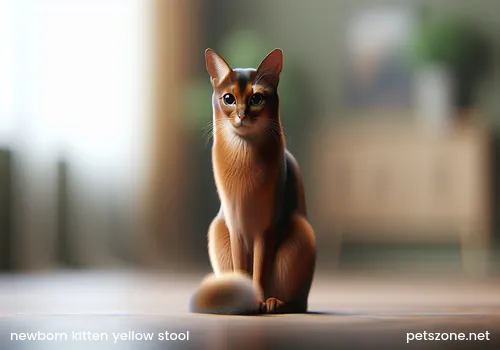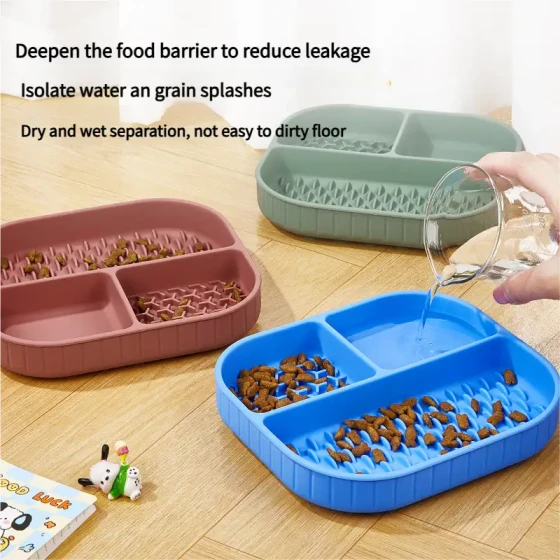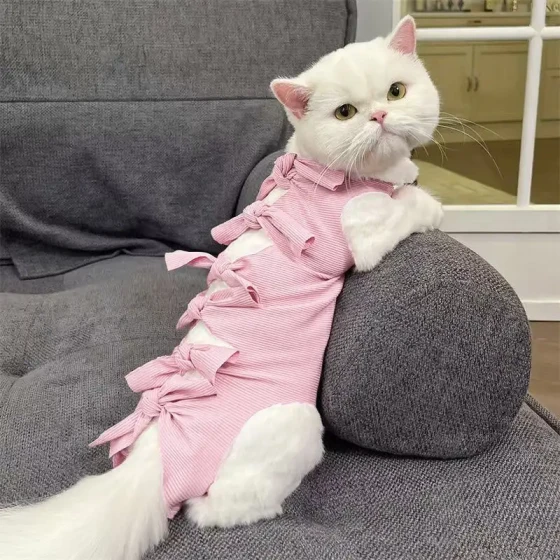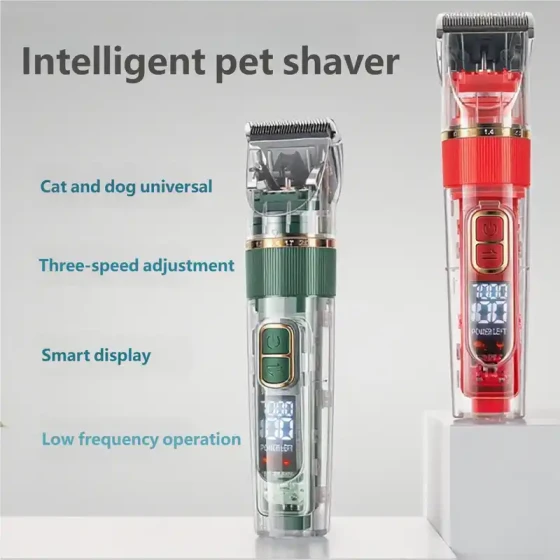Newborn Kitten Pooping Yellow_Common Causes of Yellow Stool in Kittens Explained
Newborn kittens pooping yellow stool is sometimes a normal phenomenon, such as their "cheese stool," but sometimes it may also signal health problems like indigestion, parasite infection, or more serious diseases. As cat owners, we need to observe carefully and learn to distinguish in order to take them to the vet promptly if necessary.

Yellow Stool in Kittens: Is It “Cheese Stool” or a Health Alert?
Newborn kittens, especially during their nursing stage, often have stool color and texture that puzzle new owners. If a kitten poops yellow stool, don't panic first; it may be their normal "cheese stool" or a distress signal from their body. To differentiate these two situations, the key is to observe the stool’s characteristics, odor, frequency, and the kitten’s overall mental state.
1. Normal “Cheese Stool”: Eating Well and Good Digestion!
If the kitten’s yellow stool is pasty, with a mustard yellow color or a slightly lighter shade, without a particularly foul odor, and the kitten is lively, has a good appetite, and is steadily gaining weight, congratulations, this is likely healthy "cheese stool." The characteristics of this stool mainly are:
- Color: Usually light yellow to mustard yellow.
- Texture: Soft, pasty, possibly slightly moist, but not watery or muddy.
- Odor: Usually a lactic acid smell, not a rotten or fishy stench.
- Kitten’s condition: Active and playful, normal body temperature (usually 36.1-37.8°C for kittens), voluntarily nursing, sleeping well, and gaining about 10-15 grams daily.
This “cheese stool” results from the kitten’s digestive system still developing. When digesting mother’s milk or kitten-specific milk formula, their gut flora and digestive enzymes create this unique stool color and texture—similar to human babies’ stool when breastfed, which is also loose and yellow.
2. Health Alert: When Yellow Stool Is No Longer Normal
If the kitten’s yellow stool shows the following abnormalities, be vigilant; these may indicate health issues requiring immediate veterinary attention to avoid delaying treatment.
1. Abnormal Stool Characteristics:
- Watery stool: If the stool is as loose as water, sometimes foamy, this clearly signals diarrhea. Severe diarrhea can cause rapid dehydration, very dangerous for fragile kittens.
- Mucus or bloody stool: Stool mixed with clear mucus or showing red or black blood streaks indicates possible intestinal inflammation, damage, or parasitic infection.
- Foul odor: Stool emitting a pungent rotten or fishy stench instead of normal lactic acid smell may indicate gut flora imbalance or bacterial infection.
2. Abnormal Kitten Mental State:
- Lethargy: Kitten becomes listless, inactive, slow to respond to stimuli, or emits distress cries.
- Poor appetite or refusal to eat: No voluntary nursing or refusal to feed.
- Weight loss or stagnation: The kitten’s weight does not increase and may even decrease, a very dangerous sign.
- Abdominal bloating or pain: Shows pain or obvious bloating when gently touching the abdomen.
- Dehydration: Can be judged by gently lifting the skin on the neck. If the skin doesn’t quickly return, dehydration is present.
3. Common Causes of Yellow Stool in Kittens Explained
After understanding abnormal signs, let's explore common causes of abnormal yellow stool in kittens:
1. Dietary Issues:
- Mother’s milk issues: Poor quality milk from the mother cat or maternal indigestion, with fat content too high or low, can affect kitten digestion and cause diarrhea.
- Improper feeding: For hand-fed kittens, incorrect milk powder preparation (too diluted or too concentrated), excessive feeding volume or frequency, or milk powder unsuitable for kitten’s digestive system can cause indigestion diarrhea. Especially for lactose-intolerant kittens, cow milk containing lactose is a "gastrointestinal killer," so specially formulated kitten goat milk powder must be used.
- Sudden food changes: Though for newborns mainly referring to milk sources, introducing other foods (like kitten food paste) too early may also cause gastrointestinal discomfort.
2. Parasite Infections:
- Roundworms, hookworms: The most common internal parasites in kittens. Kittens may be infected vertically from the mother or by ingesting parasite eggs. Parasites damage intestinal mucosa, affecting nutrient absorption and causing diarrhea; sometimes white, thin worms or eggs can be seen in the stool.
- Coccidia: A single-cell parasite easily infecting kittens. Coccidiosis causes diarrhea often with mucus or blood, with yellow or orange stool and foul odor.
3. Bacterial or Viral Infections:
- Bacterial infection: Such as Salmonella or E. coli, can cause intestinal inflammation, leading to watery or mucus-like yellow diarrhea with fever and lethargy.
- Viral infection: The most terrifying is Feline Panleukopenia (Cat Distemper). This virus poses a fatal threat to kittens, with symptoms including severe vomiting, watery diarrhea (possibly bloody), complete anorexia, extreme depression, and high fever. Diarrhea at early stages can be yellow then later more watery or bloody. Other infections like Feline Coronavirus can also cause digestive symptoms.
4. Environmental Factors and Stress:
- Chill: Kittens have weak temperature regulation; low environmental temperatures or prolonged exposure to cold drafts easily cause colds and digestive issues resulting in diarrhea.
- Stress response: Moving houses, changing environments, excessive noise, or frequent handling may cause stress and gastrointestinal discomfort presenting as diarrhea.
5. Other Diseases:
- Organ developmental defects: In rare cases, kittens may have congenital defects in digestive organs causing chronic indigestion.
- Poisoning: Accidental ingestion of substances toxic to cats (though rare in kittens, still needs attention).
When Should You Take a Kitten with Abnormal Stool to the Vet?
As responsible owners, once you find your kitten’s yellow stool abnormal with any of the following symptoms, take them to a licensed veterinary hospital immediately—don’t delay!
- Persistent diarrhea: Diarrhea lasting more than 12-24 hours without improvement.
- Lethargy or drowsiness: Inactive kitten, dull responses.
- Refusal to eat or vomiting: Not nursing or frequent vomiting.
- Signs of dehydration: Poor skin elasticity, sunken eyes, pale gums.
- Abnormal body temperature: Too high (above 39.5°C) or too low (below 36°C).
- Blood or foul odor in stool: Blood, black stool, or very pungent fishy smell.
- Weight loss or no weight gain: No weight gain after birth or actual weight loss.
The vet will diagnose based on symptoms, stool tests (for parasites, bacteria, virus antigen testing), and blood tests to establish causes and treatment plans.
Home Care Tips for Kitten Diarrhea (Please Follow Vet Guidance!)
While waiting for or following veterinary treatment, the following home care can provide support:
- Keep warm: Maintain the kitten’s environment at 29-32°C. Use electric heating pads (wrapped well to prevent burns) or hot water bottles, avoiding direct heat contact. A warm environment helps maintain body temperature and reduce stress.
- Hydration: If allowed by vet, give small amounts of pet oral electrolyte solutions frequently to prevent dehydration. Never give human anti-diarrheal drugs or antibiotics without guidance.
- Small frequent meals: If appetite exists, try reducing feeding volume per meal but increase frequency to lessen gastrointestinal burden.
- Cleanliness: Clean the kitten’s body and living area promptly, keeping hygiene to prevent secondary infection.
Prevention Is the Best Care
Prevention is always better than cure. For kitten diarrhea, prevention steps include:
- Maternal health management: Ensure pregnant mother cats get good nutrition and regular deworming. Healthy mothers provide quality milk and antibodies, strengthening kittens’ immunity.
- Proper feeding: Hand-fed kittens should use reputable kitten-specific milk powder brands, strictly following preparation and feeding instructions; avoid overfeeding or improper dilution.
- Environmental hygiene: Keep kittens' living space clean and dry, disinfect regularly to reduce pathogen breeding.
- Appropriate temperature: Adjust environment temperature according to kitten age to avoid extremes.
- Timely deworming: Under vet supervision, conduct first deworming by kitten age/weight and continue regularly.
- Vaccination: Follow immunization schedules, especially cat distemper vaccines to prevent fatal diseases.
Common Q&A
Q1: What stool colors are normal for newborn kittens?
A1: Besides the normal mustard yellow "cheese stool," newborn kittens sometimes have slightly greenish yellow stool during early digestive system development. As long as the texture is not watery and overall mental status is good, usually no heavy concern is needed. Persistent green stool or other symptoms warrant vet consultation.
Q2: Can kittens with yellow loose stool be given probiotics?
A2: Under vet guidance, pet-specific probiotics can be given to kittens. Probiotics help balance gut flora and improve digestion but cannot replace professional diagnosis and treatment, especially when severe symptoms occur.
Q3: How to judge if a kitten is dehydrated?
A3: Besides the neck skin lift test, observe the gums. Pale, dry mucous membranes or slow color return (>2 seconds) after pressing the gums may indicate dehydration.
Q4: How often should newborn kittens poop?
A4: Newborn kittens usually poop after each feeding because mother cats stimulate defecation by licking. Hand-fed kittens also need gentle stimulation of the anus and genital area with a warm, moist cotton ball after feeding. Pooping 2-4 times daily with a pasty texture is normal.
Summary
Newborn kittens pooping yellow stool may be normal or a warning sign. As caretakers, we must carefully observe stool texture, odor, and closely monitor kittens’ mental state, appetite, and weight changes. If abnormalities appear, avoid self-diagnosis or medication; timely professional veterinary assistance is the wisest choice. After all, for these little lives, time and expert diagnosis are keys to healthy growth.
Sources
1. American Society for the Prevention of Cruelty to Animals (ASPCA) articles on kitten care.
2. "Merck Veterinary Manual" chapters on feline digestive diseases.
3. Guidelines on small animal gastrointestinal diseases issued by the World Small Animal Veterinary Association (WSAVA).


-560x560.webp)
